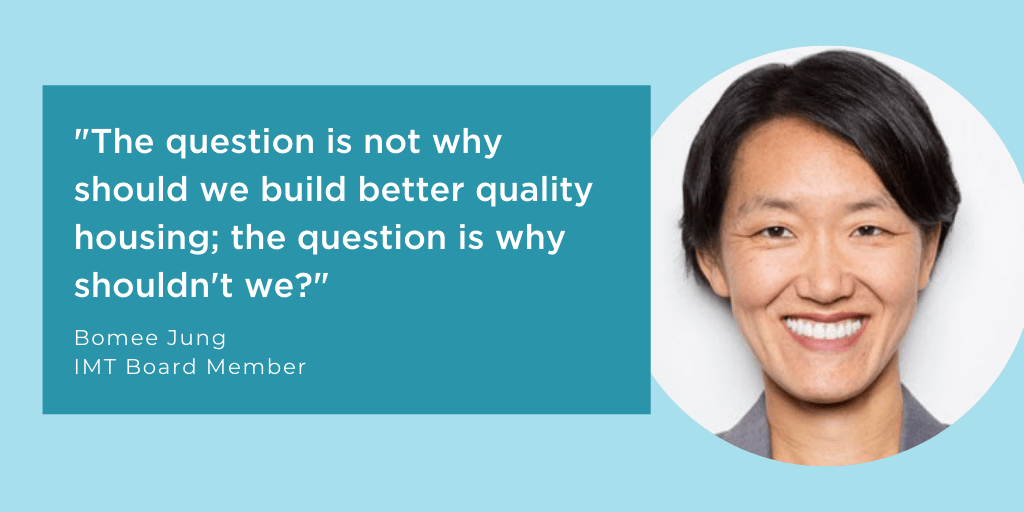Bomee Jung recently joined IMT’s board and in this interview, she shares her perspectives on equity, energy and affordability, informed by her experience working at the New York City Housing Authority and elsewhere.

What motivated you to build a career in energy and sustainability?
My first career was in developing Web applications. When the dot.com boom collapsed, I wanted to move into work more directly connected to my personal values. In taking some time out of New York and visiting other global cities, primarily in Asia, I realized that I really cared about cities and climate change. Right now more than half the world’s population lives in cities, and it will be two-thirds by 2050. There are huge opportunities to create change through climate action in cities, but the inequalities are also very stark. I decided to pursue a career in fighting climate change while making cities better, more equitable, more beautiful places.
Where does affordability intersect with building performance? Are there tensions there?
I don’t see tensions between building performance and equity, of which affordability is one aspect. I’ve been working in the affordable housing space for almost 15 years, and I hear a lot of concern that building to a higher quality means building fewer affordable units, but this comes from a framework based on scarcity. To me, the question is not why should we build better quality housing; the question is why shouldn’t we? Because of the dire consequences of the climate emergency, we should be framing this as a life safety issue. When the debate is framed in terms of broad life safety issues—for example, in New York, we have a law that any building that has more than four units has to have sprinklers—no one then has to go and justify how much it’s going to cost.
This is a really good moment to have these conversations, because of the focus on climate justice. A justice-oriented statement that reconciles it might be, “We should build the best buildings we know how to build, to house everyone, starting with the folks that our system has placed at disproportionate risks, because we are trying to level a playing field that has been tilted in the wrong direction for generations.”
We do have to recognize that we work within a particularly constrained housing policy framework. U.S. policy doesn’t fully incorporate the idea that housing is a human right. In Mexico, for example, it is enshrined in the constitution. While we recognize as a market failure the inability to offer housing that people can afford, culturally, we are very uncomfortable with unconditionally providing basic living supports. This comes from this myth we have that everyone can pull themselves up by their own bootstraps. As a result, our largest housing subsidy is the mortgage interest tax break which benefits the wealthiest members of our society, whereas in subsidies for affordable housing, we’re always asking “what is minimally sufficient?”
Our climate emergency represents a shared risk across society that gives us a chance to change that thinking. If we’re going to make investments that transform the whole economy, why would we draw the line at housing? The ubiquity of the need for housing should put it first in line for those resources. Building the best buildings we know how to build should be at the front of the queue.
Right now, the best quality means building to passive house standards, which also yield the least carbon intensive buildings. In a nutshell, what passive house guidance says is to do all the things you are normally required to do, but also test it. Most code compliance involves inspections, not instrumented testing. The power of tools like passive house is in translating quality into metrics that can be tested for quality assurance and accountability.
And then, apart from that, there’s the wealth building component of climate justice, and the aspect of frontline communities’ agency in decision making. So, moving from “doing for” to “doing with”—or even, “getting out of the way.” This is all economic activity that we’re talking about, so we have to ask “how is the economic value being generated flowing to frontline communities?” In our history, we have repeatedly appropriated and destroyed the wealth and economic power of racialized communities. We can’t go forward without understanding and fighting against that.
What excites you most about joining IMT’s Board of Directors?
I think the camaraderie on the board great and our mission orientation makes our interactions fun. Nonprofit board service is volunteer. It’s great to sit down with people who share the same goals. It’s a little party for us. The thing that is astounding to me about IMT’s work is how profound the impact is, given the relatively small size of the organization. There’s a history of managing very smart partnerships, and that’s a powerful combination.